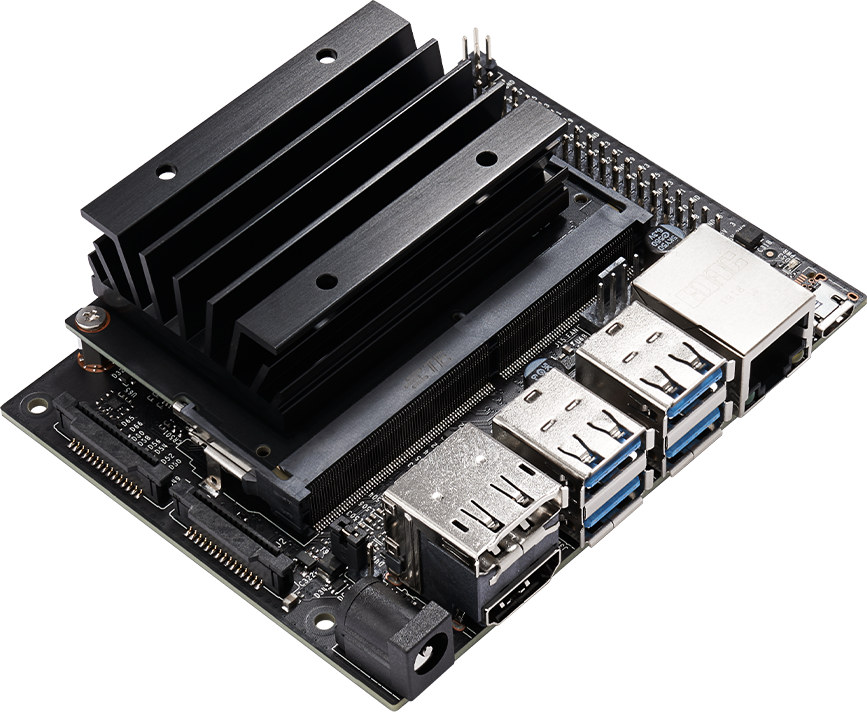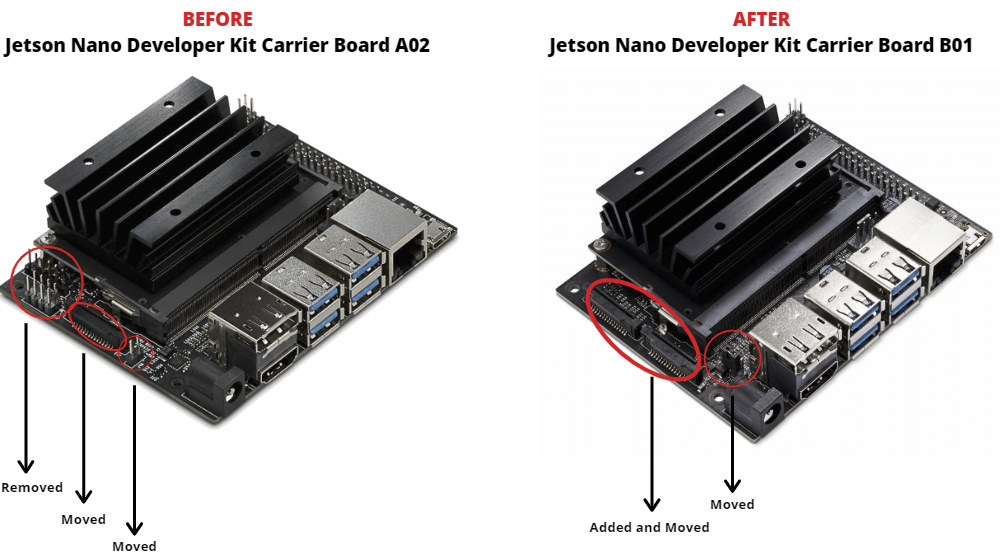Launched in March 2019, NVIDIA Jetson Nano developer kit offered an AI development platform for an affordable $99. The kit is comprised of Jetson Nano module and a carrier board, and the version I received last November ended with “A02”.
Jetson Nano developer kit is now getting updated with B01 carrier board that adds an extra MIPI CSI connector and other few changes, including compatibility with NVIDIA Jetson Nano production module (with eMMC flash instead of MicroSD card).
Jetson Nano developer kit-B01 specifications:
- B01 Jetson Nano CPU Module
- 128-core Maxwell GPU
- Quad-core Arm A57 processor @ 1.43 GHz
- System Memory – 4GB 64-bit LPDDR4 @ 25.6 GB/s
- Storage – microSD card slot
- Video Encode – 4K @ 30 | 4x 1080p @ 30 | 9x 720p @ 30 (H.264/H.265)
- Video Decode – 4K @ 60 | 2x 4K @ 30 | 8x 1080p @ 30 | 18x 720p @ 30 (H.264/H.265)
- Dimensions – 70 x 45 mm
- B01 Baseboard
- 260-pin SO-DIMM connector for Jetson Nano module.
- Video Output – HDMI 2.0 and eDP 1.4 (video only)
- Connectivity – Gigabit Ethernet (RJ45) + 4-pin PoE header
- USB – 4x USB 3.0 ports, 1x USB 2.0 Micro-B port for power or device mode
- Camera I/F – 2x MIPI CSI-2 DPHY lanes compatible with Raspberry Pi Camera Module V2
- Expansion
- M.2 Key E socket (PCIe x1, USB 2.0, UART, I2S, and I2C) for wireless networking cards
- 40-pin expansion header with GPIO, I2C, I2S, SPI, UART signals
8-pin button header with system power, reset, and force recovery related signals
- Misc – Power LED, 4-pin fan header
- Power Supply – 5V/4A via power barrel or 5V/2A via micro USB port selectable by jumper; optional PoE support
- Dimensions – 100 x 80 x 29 mm (with heatsink)
Other changes include the removal of the “button” and serial headers, and the power select header (J48) has been moved to the edge of the board. The new baseboard is also said to be compatible with the upcoming Jetson Xavier NX module, but according to a forum thread using an A02 module with a B01 carrier board will not work.
NVIDIA also released Jetpack 4.3 with the latest TensorRT 6.0.1 and cuDNN 7.6.3 libraries which are claimed to improve AI inference performance by 25%, and includes a developer preview of VPI (Vision Programming Interface) including CPU+GPU accelerated computer vision/image processing algorithms.
The price of the new Jetson Nano developer kit-B01 is still $99 and you’ll find it either directly on NVIDIA website or Seeed Studio.

Jean-Luc started CNX Software in 2010 as a part-time endeavor, before quitting his job as a software engineering manager, and starting to write daily news, and reviews full time later in 2011.
Support CNX Software! Donate via cryptocurrencies, become a Patron on Patreon, or purchase goods on Amazon or Aliexpress







I’m guessing the two csi ports are synchronized, now I won’t have to wait for the Arducam stereo hat to be jetson nano compatible!
I have the same question. Have you found more info about that?
Same question here! Is the new board stereo capable (synchronized cams)?
That’s a small but good change. That’s what the board is mostly used for, so better camera connection is what it could use for multiple cameras. I use USB3 cameras so I don’t care too much about that. I would love it if they’d bring out a better SoM for it. A higher clocked CPU would be great. And if possible more ram. For this device 4GB doesn’t seem enough. Compared to other SBC’s this eats memory for breakfast, dinner and supper.
I guess the first true 8GB SBCs will come in a few months with the RK3588. Can’t wait for a high performance octa-core SBC with recent core architecture and 8GB ram. Should be very power efficient, and very powerful. It will change everything.
I’ve been working with the XU4 the last days, it is great to see 8 cores working, tho it’s a very old architecture. If only the S922/A311D had 2 extra cores.
It is about time for something awesome to come out, I want new toys…
Greetings.
Does usb fall victim to more latency than csi? I’d much rather use my laptop than an embedded system if they’re possible.
since the 8-pin button header with system power, reset, and force recovery related signals is removed, how can we add a reset and power button option in cases like the most popular waveshare case that use these pins to connect the added peripherals?
its not removed. The specs are misleading. Pins are move on the board, right under the module (so barely visible from the image). Actually there are additional 4 pins for led’s (so total of 12 instead of 8).
I wonder if the 4 USB3 ports each support 5Git/s concurrently or if they share one 5Gbit/s lane.